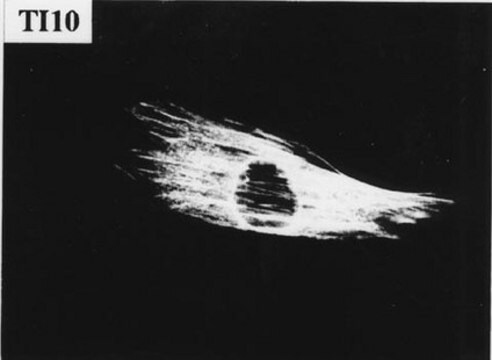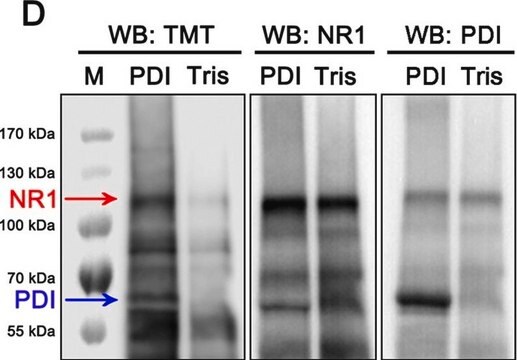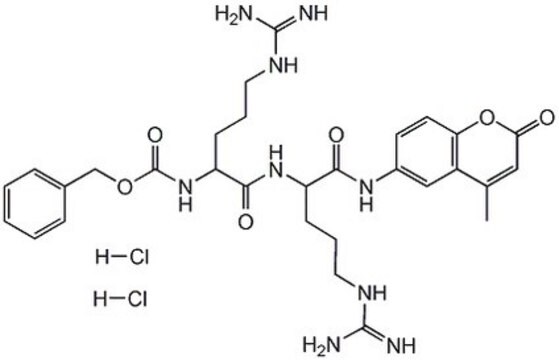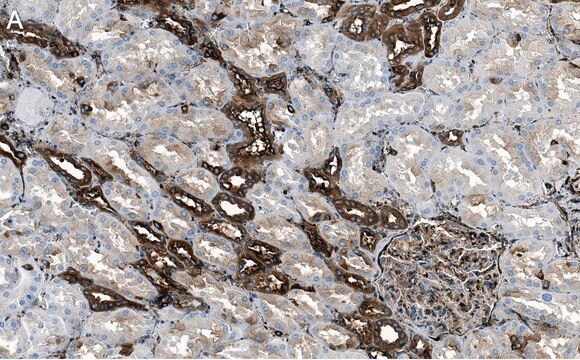MAB1678
Anti-Filamin A Antibody, clone PM6/317
ascites fluid, clone PM6/317, Chemicon®
Synonyme(s) :
Alpha-Filamin, Filamin I, Endothelial Actin-binding Protein, ABP-280, Nonmuscle Filamin
About This Item
Produits recommandés
Source biologique
mouse
Forme d'anticorps
ascites fluid
Type de produit anticorps
primary antibodies
Clone
PM6/317, monoclonal
Espèces réactives
human, rabbit, rat, guinea pig, chicken, mouse
Fabricant/nom de marque
Chemicon®
Technique(s)
immunofluorescence: suitable
immunohistochemistry (formalin-fixed, paraffin-embedded sections): suitable
immunoprecipitation (IP): suitable
western blot: suitable
Isotype
IgG1
Numéro d'accès NCBI
Numéro d'accès UniProt
Conditions d'expédition
wet ice
Modification post-traductionnelle de la cible
unmodified
Informations sur le gène
human ... FLNA(2316)
mouse ... Flna(192176)
Description générale
Spécificité
Immunogène
Application
1:1000-1:4000. Because of the large size of the unprocessed forms of filamin, 4-7% PAGE gels and proteinase inhibitors are recommended.
Immunofluorescence:
1:50-1:200 dilution from a previous lot was used. Suitable for staining both frozen and paraffin embedded tissues (at lower dilutions). Microwave-citrate buffer antigen retrieval method recommended for paraffin sections.
Immunoprecipitation:
A previous lot was used on immunoprecipitation. Suggested lysis buffer is PBS with 0.5% triton X-100 with proteinase inhibitors (note for full length filamin include calpain inhibitors). 5 microliters of antibody for every 300-500 μL of cell lysate (200-500 μg/mL total protein is suggested. Incubation is 1 hour RT or overnight 4C; Protein A/G agarose beads or rabbit anti-mouse secondary capture antibody is recommended for best recovery. 4-8% acrylamide gels are recommended for full length filamin or the 190 kDa fragement visualization.
Optimal working dilutions must be determined by end user.
Cell Structure
Cytoskeleton
Qualité
Western Blot Analysis:
1:500-1:4000 dilution of this lot detected Filamin A on 10 μg of Jurkat lysates. Because of the large size of the unprocessed forms of filamin, 4-7% PAGE gels and proteinase inhibitors are recommended.
Description de la cible
Forme physique
Stockage et stabilité
Handling Recommendations: Upon first thaw, and prior to removing the cap, centrifuge the vial and gently mix the solution. Aliquot into microcentrifuge tubes and store at -20°C. Avoid repeated freeze/thaw cycles, which may damage IgG and affect product performance.
Remarque sur l'analyse
Positive control tisse: skin, jurkat cell lysate.
Autres remarques
Informations légales
Clause de non-responsabilité
Vous ne trouvez pas le bon produit ?
Essayez notre Outil de sélection de produits.
En option
Code de la classe de stockage
12 - Non Combustible Liquids
Classe de danger pour l'eau (WGK)
nwg
Point d'éclair (°C)
Not applicable
Certificats d'analyse (COA)
Recherchez un Certificats d'analyse (COA) en saisissant le numéro de lot du produit. Les numéros de lot figurent sur l'étiquette du produit après les mots "Lot" ou "Batch".
Déjà en possession de ce produit ?
Retrouvez la documentation relative aux produits que vous avez récemment achetés dans la Bibliothèque de documents.
Notre équipe de scientifiques dispose d'une expérience dans tous les secteurs de la recherche, notamment en sciences de la vie, science des matériaux, synthèse chimique, chromatographie, analyse et dans de nombreux autres domaines..
Contacter notre Service technique







